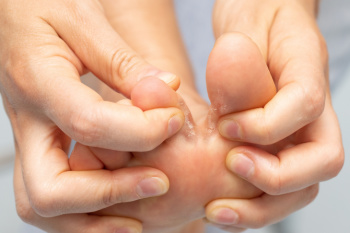
Athlete’s foot is a fungal infection that affects the skin between toes, underneath the soles, and around the ankles. Athlete's foot often causes itching, scaling, cracking, and occasional discomfort due to inflammation and moisture buildup in the foot's natural crevices. In some cases, small blisters may appear, and skin may fissure, especially in areas subject to friction from shoes or socks. When left untreated, the infection can spread across the foot and create openings that allow bacteria to enter, increasing the risk of secondary infection. A podiatrist can evaluate the extent of the infection, identify secondary complications, and recommend an appropriate course of treatment to restore skin integrity. This may involve debriding thickened skin, prescribing appropriate topical or systemic antifungal agents, and advising on footwear modifications to reduce moisture and friction. If you have developed an athlete's foot infection that has become problematic, it is suggested that you schedule an appointment with a podiatrist for appropriate treatment.
Athlete’s foot is an inconvenient condition that can be easily reduced with the proper treatment. If you have any concerns about your feet and ankles, contact Katie Besselman, DPM from Advanced Podiatry. Our doctor will treat your foot and ankle needs.
Athlete’s Foot: The Sole Story
Athlete's foot, also known as tinea pedis, can be an extremely contagious foot infection. It is commonly contracted in public changing areas and bathrooms, dormitory style living quarters, around locker rooms and public swimming pools, or anywhere your feet often come into contact with other people.
Solutions to Combat Athlete’s Foot
- Hydrate your feet by using lotion
- Exfoliate
- Buff off nails
- Use of anti-fungal products
- Examine your feet and visit your doctor if any suspicious blisters or cuts develop
Athlete’s foot can cause many irritating symptoms such as dry and flaking skin, itching, and redness. Some more severe symptoms can include bleeding and cracked skin, intense itching and burning, and even pain when walking. In the worst cases, Athlete’s foot can cause blistering as well. Speak to your podiatrist for a better understanding of the different causes of Athlete’s foot, as well as help in determining which treatment options are best for you.
If you have any questions please feel free to contact our office located in Saint Peters, MO . We offer the newest diagnostic and treatment technologies for all your foot and ankle needs.



